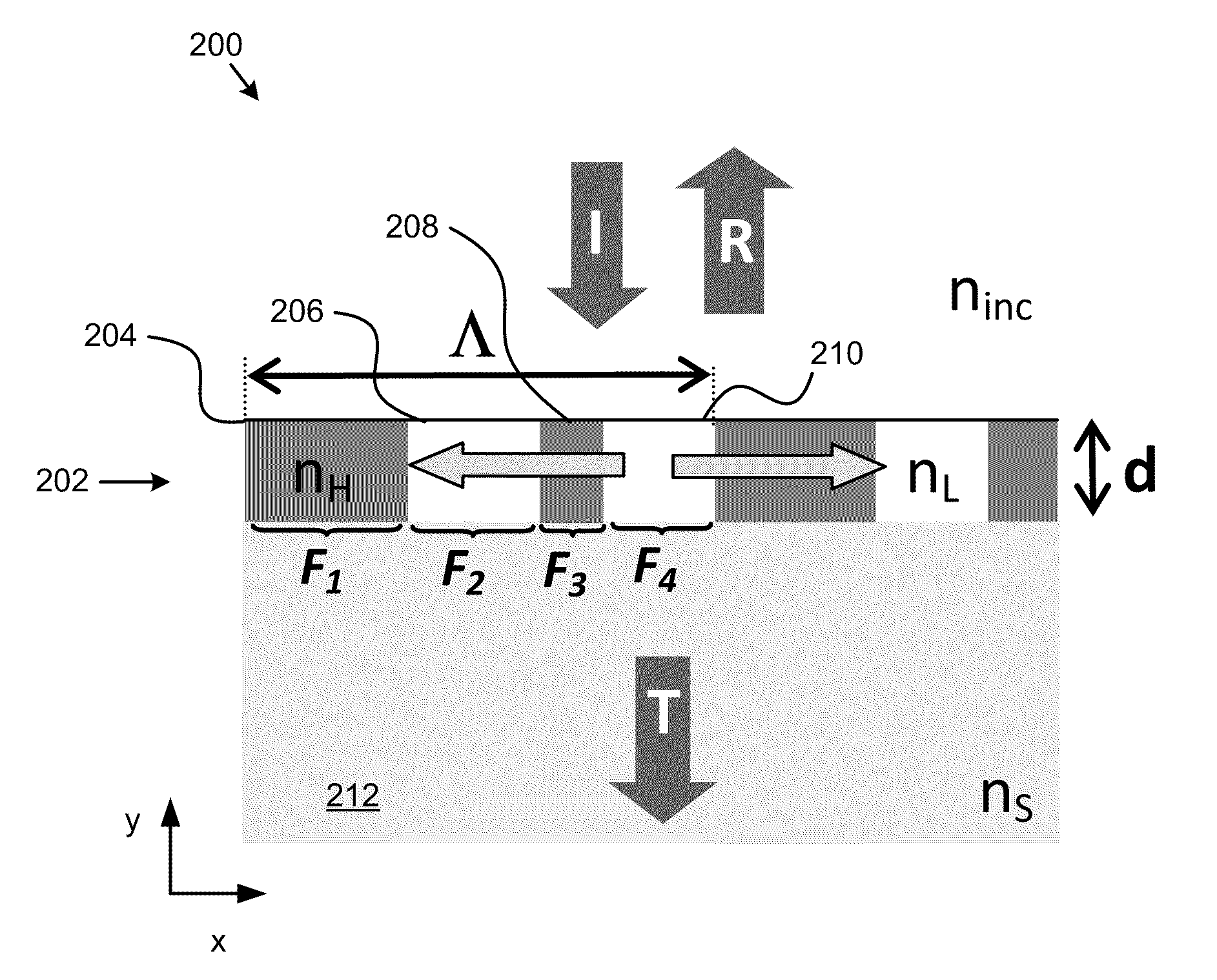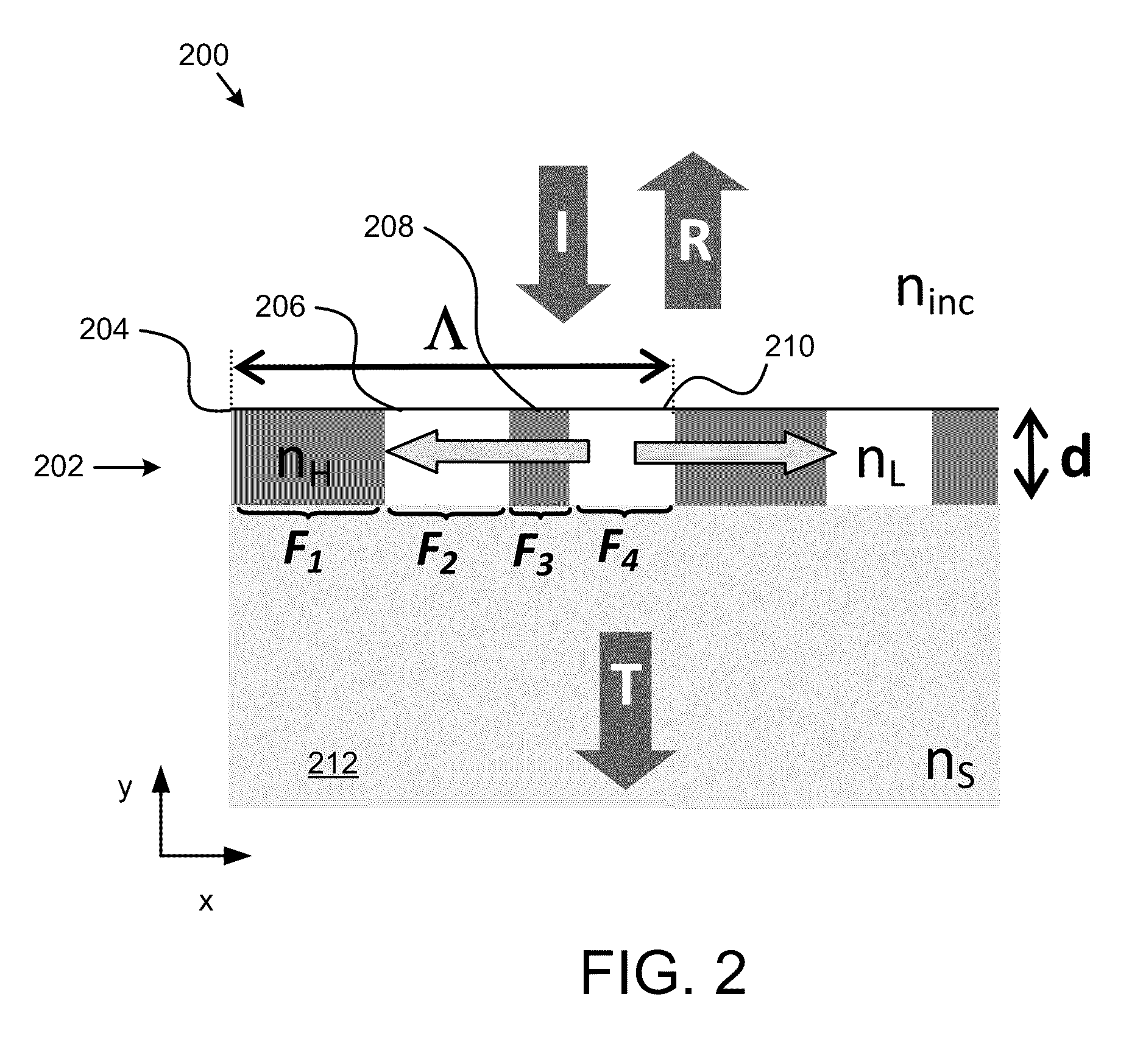Chip-Scale Slow-Light Buffers Fashioned with Leaky-Mode Resonant Elements and Methods of Using Leaky-Mode Resonant Elements for Delaying Light
a technology of leaky-mode resonant elements and slow-light buffers, which is applied in the direction of instruments, electrical equipment, laser details, etc., can solve the problems of low reflection efficiency of pulses, inability to generate mass deployment functions, and little done to understand their dispersion properties and related slow-light applications
- Summary
- Abstract
- Description
- Claims
- Application Information
AI Technical Summary
Benefits of technology
Problems solved by technology
Method used
Image
Examples
example 1
[0055]With reference to FIG. 2, an example of a silicon-on-insulator (SOI) leaky-mode resonant optical element 200 is disclosed. The spatially modulated periodic layer 202 is spatially modulated in the x-direction. It has alternating indices of refraction with a high index of refraction (nH) and a low index of refraction (nL). Components 204 and 208 have high indices of refraction, and components 206 and 210 have low indices of refraction. Components 204, 206, 208 and 210 comprise one period of the spatially modulated periodic layer. The period of spatially modulated layer 202 is denoted by Λ. Components 204, 206, 208 and 210 have widths in the x-direction of ΛF1, ΛF2, ΛF3, and ΛF4, respectively. Spatially modulated layer 202 has a depth shown by “d.” Spatially modulated periodic layer 202 is disposed on a substrate 212 having an index of refraction denoted by “nS.” The index of refraction of the medium coupled to spatially modulated layer 202 and opposite of substrate 212 is denote...
example 2
[0058]With reference to FIG. 4A, a second example is disclosed. In this example, optical element 400 includes two spatially modulated periodic layers 402 and 404, which are similar to spatially modulated periodic layer 202 shown in FIG. 2. Optical element 400 has an air gap (cavity) 406 between layers 402 and 404 to realize a ˜0.75 nm (FWHM) flat-top transmission band as shown in FIG. 4B. Again, this optical element was designed by the PSO technique described above, and its structural parameters are: Λ=1103.9 nm, d=432.2 nm, [F1, F2, F3, F4]=[0.0626, 0.3013, 0.4576, 0.1785], and dCavity=2000 nm. FIGS. 4B-E illustrate the transmittance, phase, delay, and dispersion of this device, respectively. This element shows a flat-top transmission bandwidth, which is a result of merging two adjacent narrow transmission resonances. In addition, the delay response exhibits an average of ˜7 ps in the transmission band. In comparison to the previous example, the dispersion is flatter. FIGS. 5A and ...
example 3
[0059]By cascading the structure in FIG. 4A, we can design an optical element resembling a multi-cavity photonic crystal waveguide. To illustrate, we cascaded five leaky-mode resonant subunits (NCavity=5) with spacing dB=5.0 micrometers (μm). The resulting optical element resembles the structure shown in FIG. 4A, but has ten spatially modulated periodic layers instead of two. FIGS. 6A-D show the computed results of the transmittance, phase, delay, and dispersion, respectively. Although the high-transmission bandwidth is smaller than it is for a single-layer optical element, cascading the layers results in a flat delay response of ˜30 ps over a ˜0.5 nm wavelength band. Moreover, the flat low-dispersion response illustrates that such optical elements may be used for imposing constant (and almost dispersion-free) delays on optical pulses. Theoretically, this ˜30 ps group delay for the ˜34 μm long optical element designed here corresponds to a group velocity of ˜0.0038 c (where “c” is t...
PUM
 Login to View More
Login to View More Abstract
Description
Claims
Application Information
 Login to View More
Login to View More - R&D
- Intellectual Property
- Life Sciences
- Materials
- Tech Scout
- Unparalleled Data Quality
- Higher Quality Content
- 60% Fewer Hallucinations
Browse by: Latest US Patents, China's latest patents, Technical Efficacy Thesaurus, Application Domain, Technology Topic, Popular Technical Reports.
© 2025 PatSnap. All rights reserved.Legal|Privacy policy|Modern Slavery Act Transparency Statement|Sitemap|About US| Contact US: help@patsnap.com



